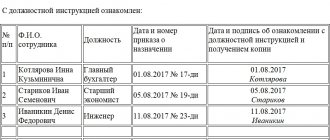Time limits for the employee to familiarize himself with the order
There are no deadlines here, they depend on the circumstances; employees are introduced to many permanent acts when hiring and concluding an employment contract (for example, internal labor regulations, etc.) However, there are a number of cases when a deadline is provided (as a rule, this is due to further actions-rights-obligations of the employee and the employer), for example: in the case when the order (instruction) to terminate the employment contract cannot be brought to the attention of the employee or the employee refuses to familiarize himself with it under signature, a corresponding entry is made on the order (instruction) (Article 84.1 ); The employer's order (instruction) to apply a disciplinary sanction is announced to the employee against signature within three working days from the date of its publication, not counting the time the employee is absent from work.
An act on the inability of the employee to sign due to absence
Anything can happen in life. For example, an employee quit, and time has already passed, and then, during an audit, it turns out that there are no signatures on the personnel documents.
Either he refused to sign, but the act was not drawn up, or they simply forgot about it in the chaos on the last working day, will you remember now? The former employee himself has already left somewhere.
So what should a personnel officer do now? Use our step-by-step instructions!
The signature of a dismissed employee may not be included in personnel documents for various reasons.
Perhaps the dismissal was a conflict, and the employee refused to sign the order, personal card, book of movement of work books and inserts in them (hereinafter referred to as the Book of Work Records).
It happens that an employee was actually absent from work on the last day of work and therefore was unable to sign the documents. It also happens that personnel officers for some reason (insufficient experience, haste, etc.) did not offer him to sign.
► Act of transfer of work books: sample
By the way, this option is also possible: upon dismissal, all documents were drawn up correctly, but upon hiring, this employee did not sign an employment contract, a hiring order, or was familiar with the local regulations of the employer, but did not sign his personal signature to confirm this put.
But what does this matter? One way or another, the employer was faced with the fact that some personnel documents do not have the signature of the resigned employee.
From July 1, new GOST. What to correct in personnel documents {amp}gt;{amp}gt;{amp}gt;
The legislation does not provide for special rules regulating this situation. Therefore, we will analyze step by step what can be done to reduce existing risks.
First of all, we document the violations detected in personnel records with the current date. To do this, you can draw up an act. Or a memo - authored by the employee who identified the violations. Regardless of the chosen registration method, it is necessary to indicate in which documents the absence of a signature was detected, who noticed it and when.
We invite you to familiarize yourself with the peculiarity of the agnates’ acceptance of the inheritance:
In order to find out whether the remaining documents for this employee are in order, in our opinion, it is worth initiating a partial personnel audit.
Based on the results of the procedure, a report is usually drawn up, which indicates in which personnel documents the employee’s signature is missing.
Now we will try to contact the former employee. To do this, letters should be sent to his last known place of residence, as well as to other known addresses, asking him to appear to sign personnel documents. Such an appeal should be sent by a valuable letter with a list of attachments.
If the former employee has moved, the letter will most likely be returned back - along with an envelope, postage marks on which will confirm that the citizen is not at the addresses known to the employer.
This way, if necessary, you can prove that you have done everything possible to correct the violation.
In addition, you should try to contact the relatives of the former employee, using the information available in the personal file, and try to find out his phone number and new place of residence.
If, as a result of all the actions taken, the ex-employee can be contacted, you can describe the current situation and ask for the address to which the company will send him documents for signature. It is advisable to document the conversation; in the drawn up report, note who called, when, what number, and what the results of the call were.
If it is possible to find out the employee’s new address, the company should send him documents in which signatures are missing (orders, employment contract, personal card), and warn him to indicate the current date when signing.
As for familiarization with local regulations, then, in our opinion, in this case it is necessary to prepare not a sheet of familiarization with local regulations, but another document.
For example, a receipt stating that when hired on such and such a date, the employee was familiarized with local regulations (indicate their details), but did not sign for familiarization in the forms and documents provided for this.
You can prepare a form and send the completed document to the employee so that he only needs to put his signature and the current date.
In addition to the documents that need to be signed, we recommend including an envelope with the company's address and a stamp attached, so that the employee only has to sign the documents, put them in the envelope and take it to the post office. The less effort required from a person, the more likely he is to respond to your request.
IT IS FORBIDDEN!
Backdating documents, that is, putting down earlier dates.
Of course, such a package of documents must be sent by a valuable letter with a list of attachments. If after some time the company receives signed documents, HR officers will be able to congratulate each other on the successful resolution of the situation.
But what should you do if you were unable to obtain the necessary signatures or find out the address of the resigned employee?
If you understand that it is impossible to obtain signatures, you should first assess the risks associated with their absence. Judicial practice shows that in this case it is possible to bring the company to administrative liability for violation of labor laws.
Judicial practice also demonstrates the possibility of holding people accountable.
Thus, the labor inspectorate brought the employer to administrative liability in the form of a fine for violating the maintenance of the Labor Book (Resolution of the Moscow City Court dated February 20, 2015 No. 4a-4207/14)
Witnesses must sign to confirm this fact. Only in this case will the act have legal force. If the employee refused to sign this document, then this can be written at the very end of the act.
There is no need to draw up a separate document regarding refusal to sign.
Suppose an employee should be fired due to absenteeism. But he refuses to sign any documents.
In this case, you need to draw up a memo, fill out an absenteeism report (failure to show up for work), try to get an explanatory note (or draw up an act of refusal to draw it up), and issue a dismissal order.
And only if the employee does not familiarize himself with the dismissal order (expressing this at least verbally), then a certificate of refusal to familiarize himself with the order is filled out.
An arbitrary form of compiling this paper is also acceptable, but it must contain all the above-mentioned information and details.
The employee must familiarize himself with the text of the act against his signature. Although, if he refused, then this does not matter much when imposing a disciplinary sanction. The main thing is that the commission members put an appropriate mark indicating that the truant refused to sign.
Refusal of “free” work cannot be interpreted as absence from work without a good reason. The legislation clearly establishes payment deadlines. If the employer delays payment for more than 15 days, then the employee has the right not to fulfill his job duties, but under one condition.
In this case, if the case goes to court, the employee, who has a copy of the application with a mark of acceptance by the enterprise administration, will be able to prove that refusal to work is forced absenteeism.
Are you here
If the employee does not want to sign to familiarize himself with the order, in this case, a Certificate of Refusal to familiarize himself with the order is drawn up.
Such a document must be drawn up in all such cases to record cases of refusal. The development of events may be different, including resolution of disputes between the employee and the employer in court.
Any document confirming the employer’s correctness can play a positive role in the consideration of the case.
This measure is necessary to prevent possible controversial situations between the employee and the organization. Any additional document will outweigh the correct actions in your favor.
And in any proceedings, such documents will allow you to defend your position.
The HR specialist draws up an act of refusal to familiarize himself with the order. The act is drawn up in free form, but indicating the required details: Most often, an act of refusal to familiarize yourself with the order is drawn up upon dismissal and transfer of an employee to another job.
The employee must be familiarized with this order (instruction) against signature. Failure by the employer to fulfill this obligation serves as one of the proofs of the employee’s innocence of committing the disciplinary offense charged to him.
Inspection against signature: how to register?
Fulfillment of labor legislation requirements, in case of improper fulfillment of which the document becomes invalid or the organization faces a fine. 3. Streamlining certain organizational and production processes. Next, we will consider how a mark of familiarization is drawn up in various types of documents.
An order is the most important administrative document with the help of which all aspects of the organization’s activities are regulated. There are three types of orders: 1) for personnel; 2) on administrative and economic activities; 3) by main activity. Note on familiarization in orders for personnel This is a special group of orders with the help of which the personnel of an enterprise is managed: hiring, dismissal, personnel changes and other actions leading to changes in work activities, as well as penalties and incentives, business trips and vacations.
Prom-Nadzor.ru
the consequence of inaccurate or incorrect execution of documents justifying the application of a disciplinary sanction, as a rule, is the emergence of a labor dispute. In cases where the employee sees a violation of his labor rights in the actions of the employer, he has the right to apply to the state labor inspectorate without any restrictions on deadlines And for the resolution of individual labor disputes - to the labor dispute commission and (or) to the court within the time limits established by law (Art.
386 and 392 of the Labor Code of the Russian Federation). The article provides for a simple procedure for applying disciplinary sanctions for such violations. At the same time, not all employers manage to avoid mistakes and violations in the procedure established by law. Moreover, in most cases, employers do not take into account the fact that the main criteria for the legality of imposing a disciplinary sanction are
This is important to know: Disciplinary action in the form of a reprimand or reprimand: consequences
Familiarization with orders in the organization
Orders on core activities are prepared on behalf of the head of the organization by heads of departments with the involvement of specialists; in some cases, when it comes to solving complex, complex issues, the head of the organization may create a commission of representatives of several departments to prepare an order. Since tasks and functions can be both basic and operational in nature, orders for core activities are classified as:
- orders for core activities - issued as part of the implementation of the main strategic and organizational tasks
- orders on administrative and organizational activities - relate to operational administrative and economic issues
REGISTRATION OF ORDERS All types of orders for core activities must be registered.
What is the deadline for reviewing the order?
The instruction on the use and completion of forms of primary accounting documentation for the accounting of labor and its payment specifies this provision, establishing the following composition of information to be recorded in the employment order: last name, first name and patronymic of the employee; name of the structural unit to which the employee was hired; profession (position) of the employee; probation; conditions of employment; the nature of the upcoming work (part-time, in the order of transfer from another organization, to replace a temporarily absent employee, to perform certain work, etc.). The same instruction also establishes the form of the order (instruction) for hiring (Form N T-1 ( T-1a)).
Advisor
Important
Today in the article we will figure out how you can collect signatures for an order, how to draw up a familiarization sheet, and what documents you need to familiarize workers with for signature. From this article you will learn:
- For which documents is it necessary to familiarize yourself with signature;
- what orders should be familiarized to workers against signature;
- How does one get acquainted with the promotion order?
According to the labor legislation of the Russian Federation, there are categories of orders, familiarization of employees with which is mandatory. Familiarization with the order against signature As follows from Article 68 of the Labor Code of the Russian Federation, the content of the order (instruction) on hiring, first of all, must exactly correspond to the terms of the employment contract concluded with this employee.
Storage period for orders for main activities
Attention
Familiarization with the order against signature There are three types of orders:
- on the main activity (published by the manager and serves to ensure the main and operational activities of the company);
- by personnel (reflects all aspects of the labor relationship between employee and employer);
- on administrative and economic issues (concerning issues such as the operation of the building, transport, security issues, etc.).
The general rule is that all persons involved in the document must be familiar with it upon signature. However, even if recognized, courts of second instance usually overturn such decisions. As an example, we can cite the appeal ruling of the Krasnodar Regional Court dated May 17, 2012 in case No. 33-7701/2012.
Familiarization with the order for signature article of the Labor Code of the Russian Federation
Info
The main inconvenience of this option is that, due to a lack of space, it is only suitable for orders without application marks, without approval, and which need to be familiarized with from one to three employees. Pay special attention to familiarize employees with orders regarding penalties. This is due to the fact that the Labor Code of the Russian Federation in Art. 193 establishes clear deadlines for familiarization with such orders: “An order (instruction) of the employer to apply a disciplinary sanction is announced to the employee against signature within three working days from the date of its publication, not counting the time the employee is absent from work.
If the employee refuses to familiarize himself with the specified order (instruction) against signature, then a corresponding act is drawn up.”
What to do if an employee refuses to get acquainted or it is impossible?
If an employee refuses to sign a dismissal order, the employer must draw up a statement of refusal to review it and put a corresponding mark on the order itself. It is advisable to draw up the act in the presence of several employees, who will subsequently be able to act as witnesses in court when appealing the dismissal.
At the same time, Art. 84.1 of the Labor Code of the Russian Federation speaks only about the impossibility of familiarizing an employee with an order without deciphering this concept. In practice, most often problems with familiarizing the employee with the order arise when dismissal for long absence, when the employee does not make himself known. In such a situation, how to inform him about the termination of the employment relationship and familiarize him with the order?
Firstly, information about the truant's home address should be in the human resources department. That is, it is impossible to fully talk about the impossibility of calling it for notification. In this case, it is enough for the employee to send a registered letter with an invitation to appear to familiarize himself with the dismissal order, receive a payment, work book, etc. An entry about this must be made in the outgoing correspondence journal.
Only after the employee fails to appear, despite proper notification, can a report be drawn up stating the impossibility of familiarizing himself with the dismissal order, guided by Part 1 of Art. 84.1 Labor Code of the Russian Federation. True, even in this case there is still a risk that in the future the employee will challenge his dismissal. He will have a month to challenge it under Art. 392 of the Labor Code of the Russian Federation, the limitation period will be calculated from the moment the dismissal order is served. Thus, the deadline for challenging it when notified by registered mail will be significantly extended.
Don't know your rights? Subscribe to the People's Adviser newsletter.
Free, minute to read, once a week.
At the same time, paragraph 45 of the resolution of the Plenum of the Supreme Court of the Russian Federation dated December 22, 1992 No. 16 clearly states that violation of the dismissal procedure may cause the employee to be reinstated in his previous position. Therefore, it is so important to make every effort to find such workers, documenting all measures taken for this purpose.
In addition, Part 1 of Art. 84.1 of the Labor Code of the Russian Federation provides for the obligation of the employer, at the request of the employee, to issue him a copy of the dismissal order, although the norm does not indicate a clear period within which this document must be provided. In this case, it remains to refer to Art. 62 of the Labor Code of the Russian Federation: since the order is a work-related document, it, along with other similar documents, is issued on the last working day. If the order was requested later, then a copy is issued within 3 working days from the date of the employee’s request.
Employee and order: dating rules
Home — News — Familiarization with the order for signature article of the Labor Code of the Russian Federation New edition of Art. 68 of the Labor Code of the Russian Federation Hiring is formalized by an order (instruction) of the employer, issued on the basis of a concluded employment contract. The content of the order (instruction) of the employer must comply with the terms of the concluded employment contract. The employer's order (instruction) regarding employment is announced to the employee against signature within three days from the date of actual start of work.
At the request of the employee, the employer is obliged to provide him with a duly certified copy of the specified order (instruction). When hiring (before signing an employment contract), the employer is obliged to familiarize the employee, against signature, with the internal labor regulations, other local regulations directly related to the employee’s work activity, and the collective agreement.
oko-dtp.ru
Separate articles are devoted to the timing of notification of dismissal, but information can be provided in writing without presenting the order itself, which means that such norms should not be considered as mandatory guidelines regarding familiarization with the order. However, Art. 62 of the Labor Code of the Russian Federation states that, at his request, an employee must be given duly certified copies of all documents accompanying his work, including a copy of the dismissal order, no later than 3 days after his request. Some people mistakenly interpret this provision as the employer’s obligation to issue a dismissal order at least 3 days before dismissal. Dedicated to the termination of an employment contract at the initiative of the employee, Art. 80 also does not provide for a period of familiarization with the order.
Orders on main activities
The legal significance of familiarizing an employee with the system of local regulations and collective agreements in force in the employer’s organization is that thereby the employee agrees to work under the conditions established by these acts. Otherwise, the parties will establish by agreement a different rule, which will constitute a condition of the employment contract. Inspection against signature: how to register?
- Themes:
- HR records management
- Orders
- Internal labor regulations
In order for the manager’s order to have legal force for execution, employees must be familiar with it. In some cases, familiarization must be confirmed by the signatures of employees who are involved in this document.
Deadlines for familiarizing yourself with the order for the main activity
The act of the employee’s refusal to familiarize himself with the order must contain the following information (Example 4): •name of the document; •place of compilation; •date of compilation; •position, full name employee; •name of the employing organization; •position, full name. employees who witnessed the fact of refusal (at least two, but, as a rule, three); •number and date of the order that the employee refuses to read; •personal signatures of witnesses. Purpose of the act: to record the refusal to sign. This will allow the employer to prove in court compliance with the requirements of the Labor Code of the Russian Federation. At the same time, the employee’s signature reads: “I don’t agree with the decision.
Malakhov. 01/20/2017" confirms the fact of familiarization with the document. That is, the employee carefully read, thought about it and even disagrees. But you will have his signature, and this is the main thing.
Procedure and terms for imposing disciplinary sanctions
The act is drawn up by several persons and consists of two parts: introductory and ascertaining. The introductory part indicates the authors of the document, the act number and the date. The ascertaining part indicates the facts recorded by the drawn up act - in this case, the refusal to give explanations by the employee who committed the disciplinary offense.
If the employee refuses to sign, the compilers sign again. Let us assume that the employee refused to give an explanation for his tardiness. Disciplinary action is applied no later than one
This is important to know: Statement of claim for divorce and collection of alimony for a child and spouse: sample








